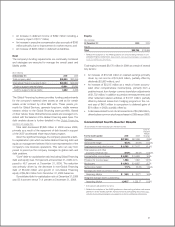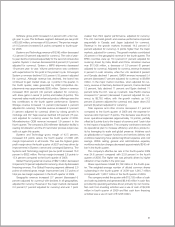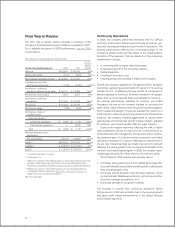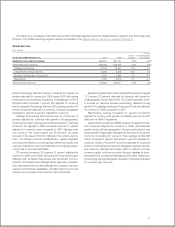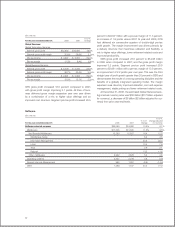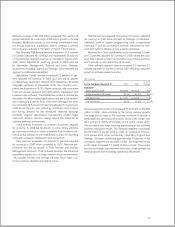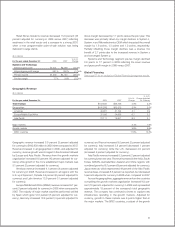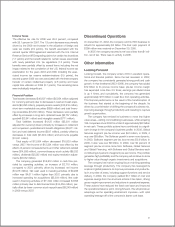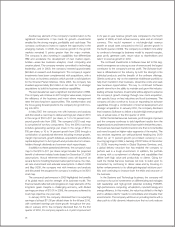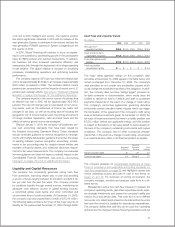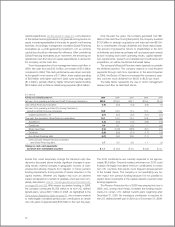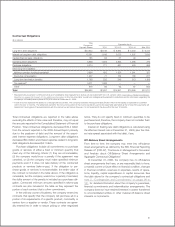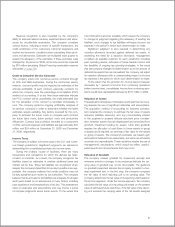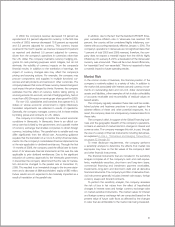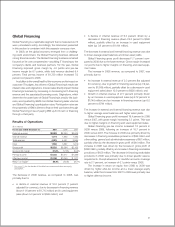IBM 2009 Annual Report Download - page 49
Download and view the complete annual report
Please find page 49 of the 2009 IBM annual report below. You can navigate through the pages in the report by either clicking on the pages listed below, or by using the keyword search tool below to find specific information within the annual report.
Income Taxes
The effective tax rate for 2008 was 26.2 percent, compared
with 28.1 percent in 2007. The 1.9 point decrease was primarily
driven by the 2008 net increase in the utilization of foreign and
state tax credits (2.9 points), the benefit associated with the
second quarter 2008 agreement reached with the U.S. Internal
Revenue Service (IRS) regarding claims for certain tax incentives
(1.7 points) and the benefit related to certain issues associated
with newly published U.S. tax regulations (1.2 points). These
benefits were partially offset by several items including the net
impact related to the completion of the U.S. federal income tax
examination for the years 2004 and 2005 including the asso-
ciated income tax reserve redeterminations (0.5 points), the
second quarter 2008 tax cost associated with the intercompany
transfer of certain intellectual property (2.8 points) and lower
capital loss utilization in 2008 (0.7 points). The remaining items
were individually insignificant.
Financial Position
Total assets decreased $10,907 million ($5,854 million adjusted
for currency) primarily due to decreases in cash and cash equiv-
alents ($2,250 million), prepaid pension assets ($15,816 million),
short-term marketable securities ($989 million) and total financ-
ing receivables ($1,233 million). These decreases were partially
offset by increases in long-term deferred taxes ($5,757 million),
goodwill ($3,941 million) and intangible assets ($771 million).
Total liabilities increased $4,123 million ($5,301 million
adjusted for currency) driven primarily by increases in retirement
and nonpension postretirement benefit obligations ($5,871 mil-
lion) and total deferred income ($547 million), partially offset by
decreases in total debt ($1,349 million) and accounts payable
($1,041 million).
Total equity of $13,584 million decreased $15,030 million
versus 2007. Net income of $12,334 million was offset by the
effects of pension remeasurements and other retirement-related
items ($14,856 million), common/treasury stock activity ($6,323
million), dividends ($2,585 million) and equity translation adjust-
ments ($3,552 million).
The company generated $18,812 million in cash flow pro-
vided by operating activities, an increase of $2,718 million,
compared to 2007, primarily driven by increased net income
($1,916 million). Net cash used in investing activities of $9,285
million was $4,611 million higher than 2007, primarily due to
increased spending for acquisitions ($5,304 million). Net cash
used in financing activities of $11,834 million increased $7,095
million primarily due to debt transactions ($14,556 million), par-
tially offset by lower common stock repurchases ($8,249 million)
in 2008 versus 2007.
Discontinued Operations
On December 31, 2002, the company sold its HDD business to
Hitachi for approximately $2 billion. The final cash payment of
$399 million was received on December 30, 2005.
In 2007, the company reported a net loss of less than $1 mil-
lion, net of tax. There was no activity in 2008.
Other Information
Looking Forward
Looking forward, the company enters 2010 in excellent opera-
tional and financial position. Since the last recession in 2002,
the company has consistently generated strong profit and cash
growth. In that timeframe (2003
–
2009), the company has added
$12 billion to its pre-tax income base; pre-tax income margin
has expanded more than 2.5 times; earnings per diluted share
is up 4 times, and cumulatively, the company has generated
approximately $115 billion in cash flow from operating activities.
This financial performance is the result of the transformation of
the business that started at the beginning of the decade. Its
driven by a combination of shifting the company’s business mix,
improving leverage through productivity and investing to capture
growth opportunities.
The company has remixed its business to move into higher
value areas—exiting commoditizing businesses, while acquiring
108 companies since 2000 for a total of approximately $22 billion
in net cash. These portfolio actions have contributed to a signifi-
cant change in the company’s business profile. In 2000, Global
Services segment pre-tax income was $4.5 billion; in 2009, it
was over $8 billion. The Software growth is even more dynamic.
In 2000, Software segment pre-tax income was $2.8 billion; in
2009, it also was over $8 billion. In 2009, over 90 percent of
segment pre-tax income came from Software, Global Services
and Global Financing, with Software and Global Services each
contributing 42 percent of segment pre-tax income. The portfolio
generates high profitability and the company will continue to remix
to higher value through organic investments and acquisitions.
The company has had an ongoing focus on driving operating
leverage through productivity. The company has leveraged its
scale and global presence to improve processes and productiv-
ity in a number of areas, including support functions and service
delivery. In 2009, the company yielded $3.7 billion of cost and
expense savings from the structural actions it has taken, driving
gross margin improvement and reductions in operational expense.
These actions have reduced the fixed cost base and improved
the operational balance point. Going forward, this will provide an
advantage as the spending environment improves—with solid
operating leverage off of the company’s leaner cost base.
47


